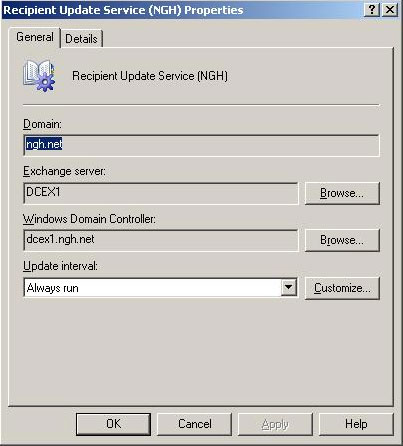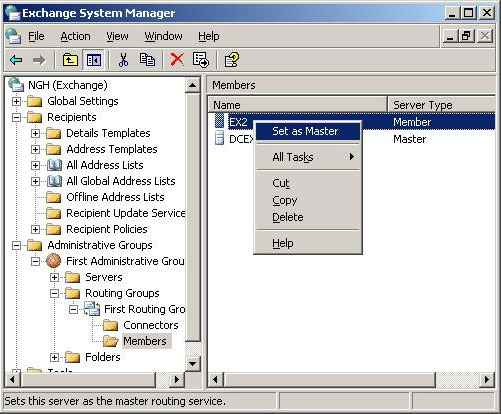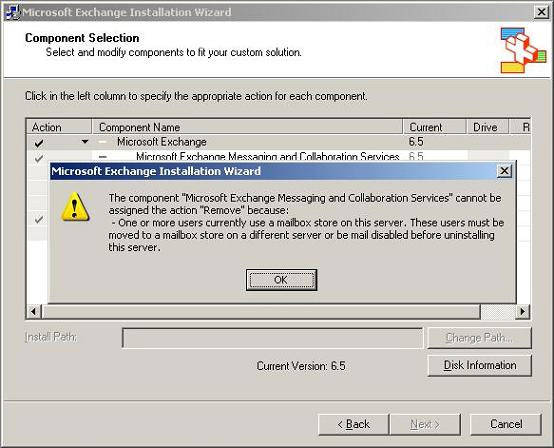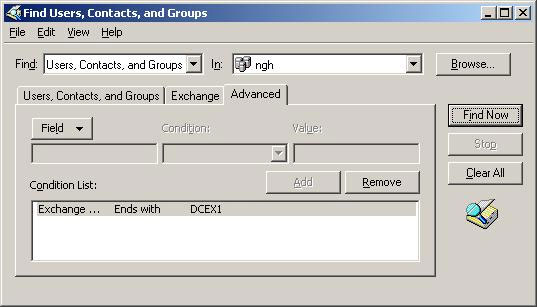Removing the first Exchange 2003 server (Part II)
The rest of the work you need to do to ensure the first Exchange server can be safely and successfully stopped.
Review part I
Introduce
Stopping an old Exchange 2003 server is a fairly easy process. But you will need to add some steps if it is the first server installed in an administrative group. The reason is that this Exchange server holds many specific configuration elements or additional roles may not switch to another Exchange server in the same administrative group. Take some time to verify that additional roles have been delivered correctly and successfully to the new Exchange server, you can help yourself avoid many headaches later when you want to deactivate servers. Other Exchange.
In Part 1 of this series, we looked at the steps needed to copy some important system folders to a new Exchange server that is also installed in the administrative group. We also provide the steps needed to ensure that the Offline Address List (Offline Address List) has been created by the new server and that no server has been shut down. In this article, I will continue the discussion of some of the remaining work to be done to ensure that the first Exchange server can be safely and successfully removed.
Reconstruct the Recipient Update Service
The Recipient Update Service, or commonly known as RUS, is an important component of Exchange 2000 and Exchange 2003 but can easily be missed during server downtime. The main task of RUS is to confirm the correct address of user accounts. Errors in the reconstruction of this component can cause the new server to lose user account authentication. Since RUS is configured with the names of both Exchange servers and domain controllers, it is natural for RUS to determine the name of the first Exchange server installed. Unless you change some points when setting up, there are some other points. You should check this configuration before the old server stops working. To change the configuration to the new Exchange server, follow these steps:
1. Run the Exchange System Manager snap-in.
2. Locate the Recipients object and expand it. Under Recipients you will see the Recipient Update Services component. Move to the location of this component.
3. Now in the right pane you will see a list of configured Recipient Update Services objects. The two smallest objects are illustrated in Figure 1. It is important to note that any RUS that has an Exchange Server column DCEX1 (server removed) needs to be fixed.

Figure 1 : Recipient Update Services
4. Right-click each RUS to rebuild and select Properties . You will see a screen similar to Figure 2 that appears.

Figure 2 : RUS Properties (RUS Properties)
5. On the General tab of the RUS Properties section, you will see that the Exchange Server field contains the name of an Exchange server. You need to make sure that this server is not the old server that will be removed (in this case, DCEX1). If the old server is set up, you need to change it by using the Browse button and selecting the new server. After clicking Browse , the Select Exchange Server window opens. Type the new server name and click the Check Names button.
6. Assuming the new server has an underlined name, click OK to return to the Properties window of the RUS. Check if the new server name is already displayed in the Exchange Server field. If available, click OK to exit. Now you can remove the dependencies of RUS on the old Exchange server. You must repeat this process with every RUS configured in this Exchange server.
Routing Group Masters
You will have to do this if you have multiple routing groups and group routing connectors in your server. You must make sure that the server you are about to remove is not the master routing group. To change the master routing group, you can follow these steps:
1. Run the Exchange Server Manager snap-in.
2. Determine the appropriate routing group and expand it. Below you will see the Members object. In the right pane, the servers in this routing group are shown. One of them is listed as Master . If this is the server that is about to be removed, you must change it again, select the master server as the new server.
3. To select a new server for the Master role, simply click on the server you want and select Set As Master . This is illustrated in Figure 3, where the EX2 server is set to be the new Routing Group Master.

Figure 3 : Setting up the Routing Group Master server
4. Every time you complete the above step, the screen will automatically refresh and the new server is now shown as master.
Additional connectors
If you already have connectors on the old server, you will have to reset them on the new server. We can take an interesting example with the X400 Connector connector, because it opens up "other end", causing each connector to be specific to an IP address (should be the IP address of the server coming down). revoke). The X400 Connecter has become less popular in the past few years, but it is still a remarkable connection.
There are not many issues worth discussing in this area. Check the connectors to see if any points are dependent on the old Exchange server.
Turn off the computer for a short time
This does not mean that after all the above steps you can rest. Now it's time to shut down the old server by removing the Exchange server software from it. But you should wait! It is better to turn off Exchange services for a period of time, at least for a few days, preferably a week to make sure that nothing happens. The last thing you need to do is restore a server because someone or something may still depend on the old server. Turning off the old server for a week will give you time to see if there is any further problem.
Remove Exchange
This last step seems to be too common in public news groups, email lists and on website forums. If you have copied all public folders, converted the entire user mailbox and followed the instructions in this article, you are now ready to remove the Exchange server software from the old server.
However, after setting the "Action" field to "Remove" to remove the Microsoft Exchange component in the Exchange Installation Wizard, you will see an error like Figure 4:

Figure 4 : Existing Mailboxes Error (Error: Existing mailboxes)
Why does this error appear when everything is ready to be removed? That's because you still have some Active Directory objects that are configured by Exchange properties in this server. To find those objects, follow these steps:
1. Run Active Directory Users and Computers.
2. Right-click the domain name at the top of the left pane and select Find from the context menu.
3. In the Find Users , Contacts , and Groups window, click the Advanced tab.
4. Click the Field button and select User . On the list of properties shown, select Exchange Home Server .
5. Set the Condition field to Ends With and type the old Exchange server name into the Value field.
6. Click Add to add this condition to Condition List . (An example of this is illustrated in Figure 5).
7. Click the Find Now button and you are provided with a list of objects that are still in Exchange properties. You need to delete them before removing the Exchange server. But you don't need to worry about system mailboxes.

Figure 5 : Find Exchange properties
After completing this final task, you can insert the Exchange server software CD into the removed server, run setup (the installation program) and proceed to remove the server.
Summary
When you want to deactivate an old Exchange server, you do not need to touch the power button because there are a number of procedures that allow you to perform completely on the software. Especially when removing the first Exchange server installed in the administrative group, it is even more necessary to be careful. Hopefully the content of this article provides enough information to help you successfully and accurately remove the first Exchange server mentioned above.
You should read it
- Discover EMC in Exchange Server 2010 (Part 2)
- Switch from Exchange 2000/2003 to Exchange Server 2007 (part 1)
- Transfer Exchange 2003 to Exchange 2007 (Part 2)
- 6 leading Exchange Server monitoring software
- Transfer Exchange 2003 to Exchange 2007 (P.7)
- Transfer Exchange 2003 to Exchange 2007 (P.6)
- Mobile communications with Exchange Server 2007 - Part 1: New device features and improvements
- Removing the first Exchange 2003 server (Part I)
May be interested
- Additions for Exchange Server 2007 - Part 1: Introduction steps
 in this series, i will show you how to add exchange server 2007 sp1 (beta), installed on windows server 2008 (also beta). we talked about the steps needed to add the underlying operating system by only installing a minimum number of server roles and services. in the second part, we plan to do it
in this series, i will show you how to add exchange server 2007 sp1 (beta), installed on windows server 2008 (also beta). we talked about the steps needed to add the underlying operating system by only installing a minimum number of server roles and services. in the second part, we plan to do it - Discover EMC in Exchange Server 2010 (Part 1)
 in exchange server 2010, powershell cmdlets has been greatly improved to manage multiple tools, and administrative tasks are made easier on emc.
in exchange server 2010, powershell cmdlets has been greatly improved to manage multiple tools, and administrative tasks are made easier on emc. - Forward from Exchange 2000/2003 to Exchange Server 2007 (part 2)
 this is the next installment of a series of three tutorials on how to forward a server from exchange 2000 or 2003 to exchange 2007, deployed in the same active directory forest. for the purposes of this article, we will only install an exchange 2007 server, with the chapter
this is the next installment of a series of three tutorials on how to forward a server from exchange 2000 or 2003 to exchange 2007, deployed in the same active directory forest. for the purposes of this article, we will only install an exchange 2007 server, with the chapter - Introducing Exchange Server 2019, how to install Exchange Server 2019
 exchange server 2019 is designed to deliver security, performance, and improved manageability and operations - properties microsoft's biggest customers have come to expect from exchange.
exchange server 2019 is designed to deliver security, performance, and improved manageability and operations - properties microsoft's biggest customers have come to expect from exchange. - Use remote connection analysis tool for Exchange Server - Part 1
 in this article we will introduce you to the exchange server remote connectivity analyzer (exrca) tool so that administrators can validate autodiscover, ....
in this article we will introduce you to the exchange server remote connectivity analyzer (exrca) tool so that administrators can validate autodiscover, .... - Additions for Exchange Server 2007 - Part 2: Default protection
 before you begin, note that this article is based on the beta version of windows server 2008 and exchange server 2007 sp1, so it may have some features changed or removed in the final versions. same of products.
before you begin, note that this article is based on the beta version of windows server 2008 and exchange server 2007 sp1, so it may have some features changed or removed in the final versions. same of products. - Backup for Exchange Server with DPM 2007 (Part 1)
 although we can still use earlier versions of dpm (dpm 2006) to back up exchange server, it does include a two-step method. with the new version, dpm 2007 is used to support online exchange backup, so you won't need to
although we can still use earlier versions of dpm (dpm 2006) to back up exchange server, it does include a two-step method. with the new version, dpm 2007 is used to support online exchange backup, so you won't need to - Checking Exchange Server 2007 with MOM 2005 (Part 1)
 the main goal of this series is to show you how a mom 2005 sp1 tool supports the exchange server 2007 environment. exchange server 2007 has five separate roles (roles) and we will check to see the status of the root
the main goal of this series is to show you how a mom 2005 sp1 tool supports the exchange server 2007 environment. exchange server 2007 has five separate roles (roles) and we will check to see the status of the root - Managing log files of Exchange Server 2007 - Part 2
 in this article, i will show you some other ways to get log information in exchange server 2007.
in this article, i will show you some other ways to get log information in exchange server 2007. - Managing Resource Mailboxes in Exchange Server 2007 (Part 2)
 in the previous part of this series, we learned how to create a resource mailbox and how to enable it so that a user can access it through the add-mailboxpermission cmdlet. at that time, we still couldn't do this through the exchange management console, but today with exchange server 2007 service pack 1
in the previous part of this series, we learned how to create a resource mailbox and how to enable it so that a user can access it through the add-mailboxpermission cmdlet. at that time, we still couldn't do this through the exchange management console, but today with exchange server 2007 service pack 1










 Installing Exchange 2007 (Part II)
Installing Exchange 2007 (Part II) Secure Outlook Web Access using SSL
Secure Outlook Web Access using SSL Switch from Exchange 2000/2003 to Exchange Server 2007 (part 1)
Switch from Exchange 2000/2003 to Exchange Server 2007 (part 1) Use Admodify.net for Exchange 2003 administration and recovery
Use Admodify.net for Exchange 2003 administration and recovery Convert from Exchange 2000/2003 to Explorer Server 2007 (Part 3)
Convert from Exchange 2000/2003 to Explorer Server 2007 (Part 3)